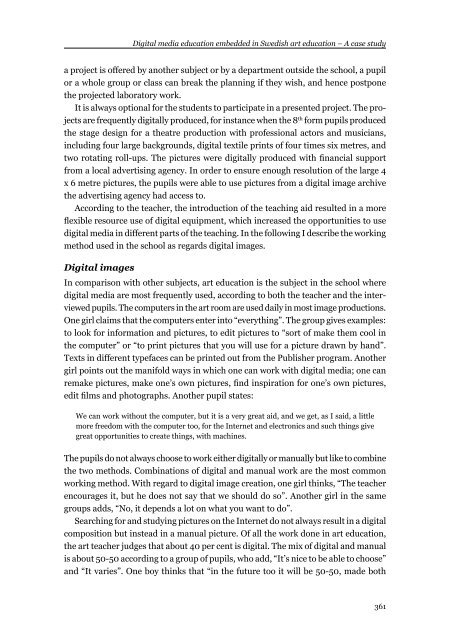Download issue - Umeå universitet
Download issue - Umeå universitet
Download issue - Umeå universitet
You also want an ePaper? Increase the reach of your titles
YUMPU automatically turns print PDFs into web optimized ePapers that Google loves.
Digital media education embedded in Swedish art education – A case study<br />
a project is offered by another subject or by a department outside the school, a pupil<br />
or a whole group or class can break the planning if they wish, and hence postpone<br />
the projected laboratory work.<br />
It is always optional for the students to participate in a presented project. The projects<br />
are frequently digitally produced, for instance when the 8 th form pupils produced<br />
the stage design for a theatre production with professional actors and musicians,<br />
including four large backgrounds, digital textile prints of four times six metres, and<br />
two rotating roll-ups. The pictures were digitally produced with financial support<br />
from a local advertising agency. In order to ensure enough resolution of the large 4<br />
x 6 metre pictures, the pupils were able to use pictures from a digital image archive<br />
the advertising agency had access to.<br />
According to the teacher, the introduction of the teaching aid resulted in a more<br />
flexible resource use of digital equipment, which increased the opportunities to use<br />
digital media in different parts of the teaching. In the following I describe the working<br />
method used in the school as regards digital images.<br />
Digital images<br />
In comparison with other subjects, art education is the subject in the school where<br />
digital media are most frequently used, according to both the teacher and the interviewed<br />
pupils. The computers in the art room are used daily in most image productions.<br />
One girl claims that the computers enter into “everything”. The group gives examples:<br />
to look for information and pictures, to edit pictures to “sort of make them cool in<br />
the computer” or “to print pictures that you will use for a picture drawn by hand”.<br />
Texts in different typefaces can be printed out from the Publisher program. Another<br />
girl points out the manifold ways in which one can work with digital media; one can<br />
remake pictures, make one’s own pictures, find inspiration for one’s own pictures,<br />
edit films and photographs. Another pupil states:<br />
We can work without the computer, but it is a very great aid, and we get, as I said, a little<br />
more freedom with the computer too, for the Internet and electronics and such things give<br />
great opportunities to create things, with machines.<br />
The pupils do not always choose to work either digitally or manually but like to combine<br />
the two methods. Combinations of digital and manual work are the most common<br />
working method. With regard to digital image creation, one girl thinks, “The teacher<br />
encourages it, but he does not say that we should do so”. Another girl in the same<br />
groups adds, “No, it depends a lot on what you want to do”.<br />
Searching for and studying pictures on the Internet do not always result in a digital<br />
composition but instead in a manual picture. Of all the work done in art education,<br />
the art teacher judges that about 40 per cent is digital. The mix of digital and manual<br />
is about 50-50 according to a group of pupils, who add, “It’s nice to be able to choose”<br />
and “It varies”. One boy thinks that “in the future too it will be 50-50, made both<br />
361

















